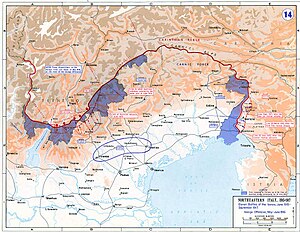| This article includes a list of general references, but it lacks sufficient corresponding inline citations. Please help to improve this article by introducing more precise citations. (February 2013) (Learn how and when to remove this message) |
| Fourth Battle of the Isonzo | |||||||
|---|---|---|---|---|---|---|---|
| Part of the Italian Front (World War I) | |||||||
 Eleven Battles of the Isonzo June 1915 – September 1917 | |||||||
| |||||||
| Belligerents | |||||||
|
|
| ||||||
| Commanders and leaders | |||||||
|
|
| ||||||
| Strength | |||||||
|
370 battalions 1,374 guns |
155 battalions 626 guns | ||||||
| Casualties and losses | |||||||
| 49,500 (7,500 dead) | 32,100 (4,000 dead) | ||||||
The Fourth Battle of the Isonzo was fought between the armies of Kingdom of Italy and those of Austria-Hungary on the Italian Front in World War I, between 10 November and 2 December 1915.
Overview
In contrast to the previous three battles of the Isonzo (in June, July and October), this offensive was brief, and is considered a continuation of the third battle of the Isonzo.
Most of the clash was concentrated in the direction of Gorizia and on the Karst Plateau, though the push was distributed on the whole Isonzo front. The Italian Second Army, aiming for the town of Gorizia, was able to capture the hilly area around Oslavia (Oslavje) and San Floriano del Collio (Števerjan) overlooking the Soča (Isonzo) and Gorizia itself. The Italian Third Army, covering the rest of the front up to the sea, launched a series of large attacks which brought no significant gain.
Mount Sei Busi was unsuccessfully attacked by Italians five times.
The intensity of the fighting increased until the end of November, when the bridgehead of Tolmin (Tolmino) was heavily shelled and casualties peaked. In the first fifteen days of December, however, the fighting was reduced to small scale skirmishes as opposed to the massive frontal assaults that characterized the previous phases of the battle.
An unsigned truce on the Karst Plateau was made as the temperatures dropped, and operations were ceased due to lack of supplies.
The Austro-Hungarian High Command, worried by huge losses, requested assistance from the German Empire, which was not yet formally in the war against Italy. German Empire intervened on the Italian Front in eleventh battle of the Isonzo.
See also
References
- Tommasi, Giuseppe (1925). Brigata Sassari. Note di guerra (PDF). Rome: Tipografia sociale. p. 58. Archived from the original (PDF) on 2020-10-29. Retrieved 2020-02-11.
Further reading
- Macdonald, John, and Željko Cimprič. Caporetto and the Isonzo Campaign: The Italian Front, 1915-1918. Barnsley, South Yorkshire: Pen & Sword Military, 2011. ISBN 9781848846715 OCLC 774957786
- Schindler, John R. (2001). Isonzo: The Forgotten Sacrifice of the Great War. Praeger. ISBN 0275972046. OCLC 44681903.
External links
- FirstWorldWar.Com: The Battles of the Isonzo, 1915-17
- Battlefield Maps: Italian Front
- 11 battles at the Isonzo
- The Walks of Peace in the Soča Region Foundation. The Foundation preserves, restores and presents the historical and cultural heritage of the First World War in the area of the Isonzo Front for the study, tourist and educational purposes.
- The Kobarid Museum (in English)
- Društvo Soška Fronta (in Slovenian)
- Pro Hereditate - extensive site (in En/It/Sl)
45°58′9″N 13°36′40″E / 45.96917°N 13.61111°E / 45.96917; 13.61111
Categories: